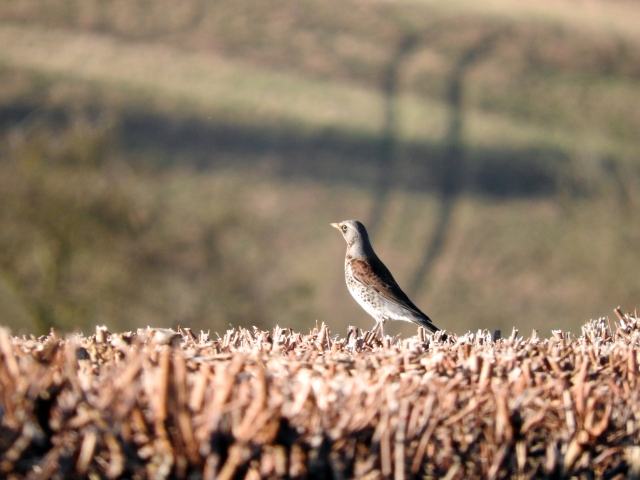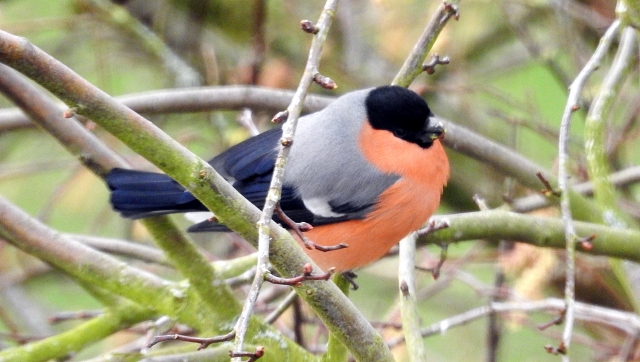
In the first week of January there is always a glimmer of hope in my mind that I might soon see or hear a hint of the spring ahead. Here in South Shropshire our January weather alternated between clear and cold or mild and damp, and plenty of small birds, especially tits and finches, were using the feeders. Goldfinches frequently left the nyger seeds to find food on the lavender in the borders or on the docks in the hedges. At the end of the first week the goldfinches were joined by a couple of bright yellow siskins – my favourite finch by far. With a surfeit of apples still lying around under the orchard trees, fieldfares continued to be regular visitors, together with a gang of male blackbirds. A single brambling appeared on the feeders on the 12th. 
Where mammals were concerned in the garden this month there were very few sightings, just the familiar mole hills around the grassy areas and grey squirrels, including our resident ‘bobtailed’ individual gathering up spilt food from the bird feeders. A single buzzard visited the garden frequently, often perching on the back of one of the garden seats and the local gang of long-tailed tits polished off the suet blocks at an alarming rate. Jays continued to dig up the acorns they buried here in the autumn.
The second week of the month was cold and dank but this miserable weather brought even more birds to the garden including a flock of around forty linnets on a couple of occasions, both to feed on natural seeds, especially water mint, and to drink from the small marshy pond. The fieldfare flock built up again to about thirty five birds especially on frosty mornings, and on the 11th of the month a great tit was heard singing – a fantastic sound! Catkins were lengthening beautifully in the hazels around the garden – a real sign of spring.

More snow arrived on the 20th which was inevitable, but it didn’t last long although the weather continued to be very cold. It was wonderful to see a kestrel hovering in our area on the 21st – the first I have seen here for more than a year. Red kites, crows and buzzards continued to dominate the sky over the garden with the occasional raven also flying over. I spent the last week of the month working on the Isle of Anglesey. The  gardens there were a little more advanced than mine with snowdrops and crocuses in flower, but the highlight as usual were the red squirrels which were easy to see at various garden feeding stations. It was also good to see plenty of house sparrows around the local area there – birds that I rarely see in my own garden now. A visit to South Stack gave us a fantastic opportunity to watch the choughs there, some of which have now learned to use the bird feeders. The month ended with some brighter weather back in South Shropshire with hazel catkins fully open and great views of a male bullfinch feeding on the buds of hawthorn in the garden.
gardens there were a little more advanced than mine with snowdrops and crocuses in flower, but the highlight as usual were the red squirrels which were easy to see at various garden feeding stations. It was also good to see plenty of house sparrows around the local area there – birds that I rarely see in my own garden now. A visit to South Stack gave us a fantastic opportunity to watch the choughs there, some of which have now learned to use the bird feeders. The month ended with some brighter weather back in South Shropshire with hazel catkins fully open and great views of a male bullfinch feeding on the buds of hawthorn in the garden.


Another fantastic account.
Wow, feeder feeding Chough, who’d have thought that was possible. Corvids aren’t half clever though, so perhaps we should expect such traits.
Best Wishes
Tony Powell and naturestimeline
LikeLiked by 1 person
Yes they are pretty smart birds! Although there was something about it that was a bit weird. I’m used to seeing them hopping about on cliffs!
LikeLiked by 1 person
So would I be, and Thanks for the follow at naturestimeline, much appreciated.
Best Wishes
Tony
LikeLike